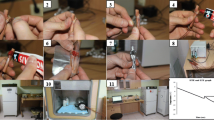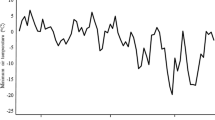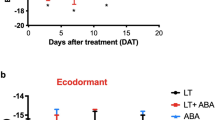Abstract
The number of pre-bloom, bloom and fruit-set source leaves are the most important determinant of tolerance of buds to low temperatures during winter. In this study, we tested whether pre-bloom (LR-PB), bloom (LR-FB) and fruit-set (LR-FS) hand defoliation are effective in interacting the cold hardiness and biochemical parameters in dormant buds (basal-medium and apical buds) of a high-yielding cultivar Karaerik during period of 2-year field study. In the LR-PB contrary to control (C) was found that basal-medium buds showed high-temperature exotherm (HTE) values and low-temperature exotherm (LTE) values at high temperatures than apical buds; therefore, basal-medium buds (1st, 2nd, 3rd, 4th and 5th) had less tolerance to low temperature than apical buds (6th, 7th, 8th, 9th and 10th). Additionally, the contents of the soluble carbohydrates increased in buds apical after the LR-PB treatment, while malondialdehyde (MDA), hydrogen peroxide (H2O2) and superoxide radical (O2·−) were decreased. The results from defoliation indicated that the LTE values are positively correlated with water content, MDA, H2O2 and O2·− and are negatively correlated with soluble carbohydrates content. Particularly, LR-PB treatment played the key role to explain the difference of cold hardiness between basal-medium and apical buds. Therefore, since LR-PB treatment does not have a negative effect on basal bud survival and increases the survival of apical buds in cool climatic regions, it could be used as a powerful technique for grape cultivars with poor basal buds fruitfulness.

Similar content being viewed by others
References
Alessandrini M, Battista F, Panighel A, Flamini R, Tomasi D (2018) Effect of pre-bloom leaf removal on grape aroma composition and wine sensory profile of Semillon cultivar. J Sci Food Agric 98(5):1674–1684
Andrews PK, Sandidge CRIII, Toyoma TK (1984) deep super-cooling of dormant and 356 deacclimating Vitis buds. Am J Enol Vitic 35:175–177
Badulescu R, Ernst M (2006) Changes of temperature exotherms and soluble sugars in grapevine (Vitis vinifera L.) buds during winter. J Appl Bot Food Qual 80(2):165–170
Bubola M, Sivilotti P, Janjanin D, Poni S (2017) Early leaf removal has larger effect than cluster thinning on cv. Teran grape phenolic composition. Am J Enol Vitic 68:234–242
Buztepe A, Kose C, Kaya O (2017) Evaluation of cold tolerance of dormant buds according to position using thermal analysis in Karaerik (V. vinifera L.) grape. Int J Res Rev 4(10):38–45
Candolfi-Vasconcelos MC, Koblet W (1990) Yield, fruit quality, bud fertility and starch reserves of the wood as a function of leaf removal in Vitis vinifera—evidence of compensation and stress recovering. Vitis 29:199–221
Caspari HW, Lang A, Alspach P (1998) Effects of girdling and leaf removal on fruit set and
Chalfant P (2012) Responses of Grapevines to timing and method of leaf removal (Doctoral dissertation, The Ohio State University)
Dami I, Ferree DC, Kurtural SK, Taylor BH (2005) Influence of crop load on ‘Chambourcin’ yield, fruit quality, and winter hardiness under Midwestern United States environmental conditions. Acta Hortic 689:203–208
Eichhorn KW, Lorenz DH (1977) Phenological development stages of the grape vine. Nachrichtenblatt des Deutschen Pflanzenschutzdienstes 29(8):119–120
Elstner EF, Heaped A (1976) Inhibition of nitrite formation from hydroxyl ammonium–chloride: a simple assay for superoxide dismutase. Anal Biochem 70:616–620
Ershadi A, Karimi R, Mahdei KN (2016) Freezing tolerance and its relationship with soluble carbohydrates, proline and water content in 12 grapevine cultivars. Acta Physiol Plant 38(1):2
Fennell A (2004) Freezing tolerance and injury in grapevines. J Crop Improvement 10(1–2):201–235
Ferree DC, Cahoon GA, Scurlock DM, Brown MV (2003) Effects of time of cluster thinning grapevines. Small Fruits Rev 2:3–14
Frioni T, Acimovic D, Tombesi S, Sivilotti P, Palliotti A, Poni S, Sabbatini P (2018) Changes in within-shoot carbon partitioning in Pinot noir grapevines subjected to early basal leaf removal. Front Plant Sci 9:1122
Frioni T, Acimovic D, VanderWeide J, Tombesi S, Palliotti A, Gatti M et al (2019) Whole-canopy source-sink balance at bloom dictates fruit set in cv. pinot noir subjected to early leaf removal. Am J Enol Vitic 70(4):411–419
Gatti M, Bernizzoni F, Civardi S, Poni S (2012) Effects of cluster thinning and preflowering leaf removal on growth and grape composition in cv. Sangiovese. Am J Enol Vitic 63:325–331
Grant TN, Dami IE (2015) Physiological and biochemical seasonal changes in Vitis genotypes with contrasting freezing tolerance. Am J Enol Vitic 66(2):195–203
Griffith M, Brown GM (1982) Cell wall deposits in winter rye Secale cereale L. ‘Puma’ during cold acclimation. Bot Gaz 143:486–490
Guy CL (1990) Cold acclimation and freezing stress tolerance: role of protein metabolism. Annu Rev Plant Physiol Plant Mol Biol 41:187–223
Hamman RA, Dami IE, Walsh TM, Stushnoff C (1996) Seasonal carbohydrate changes and cold hardiness of chardonnay and Riesling grapevines. Am J Enol Vitic 47(1):31–36
He JM, Xu H, She XP, Song XG, Zhao WM (2005) The role and the interrelationship of hydrogen peroxide and nitric oxide in the UV-B-induced stomatal closure in broad bean. Funct Plant Biol 32(3):237–247
Hed B, Centinari M (2018) Hand and mechanical fruit-zone leaf removal at prebloom and fruit set was more effective in reducing crop yield than reducing bunch rot in ‘Riesling’ grapevines. Hortic Technol 28:296–303
Hed B, Ngugi HK, Travis JW (2015) Short and long-term effects of leaf removal and gibberellin on Chardonnay grapes in the Lake Erie region of Pennsylvania. Am J Enol Vitic 66:22–29
Hickey CC, Wolf TK (2018) Leaf removal effects on Cabernet franc and Petit Verdot: I. Crop yield components and primary fruit composition. Am J Enol Vitic 69(3):221–230
Hickey CC, Kwasniewski MT, Wolf TK (2018) Leaf removal effects on cabernet franc and Petit Verdot: II. Grape carotenoids, phenolics, and wine sensory analysis. Am J Enol Vitic 69(3):231–246
Hunter JJ, Le Roux DJ (1992) The effect of partial defoliation on development and distribution of roots of Vitis vinifera L. cv. Cabernet Sauvignon grafted onto rootstock 99 Richter. Am J Enol Vitic 43(1):71–78
Hunter JJ, Visser JH (1988) The effect of partial defoliation, leaf position and developmental stage of the vine on the photosynthetic activity of Vitis vinifera L. cv Cabernet Sauvignon
Imlay JA, Linn S (1988) DNA damage and oxygen radical toxicity. Science 240(4857):1302–1309
Intrieri C, Filippetti I, Allegro G, Centinari M, Poni S (2008) Early defoliation (hand vs mechanical) for improved crop control and grape composition in Sangiovese (Vitis vinifera L.). Aust J Grape Wine Res 14:25–32
Jalel CA, Marianna P, Shankar B, Kishorekumar A, Panneerselvam R (2007) Calcium chloride effects on salinity-induced oxidative stress, proline metabolism and indole alkaloid accumulation in Catharanthus roseus. CR Biol 330(9):674–683
Jiang HY, Li W, He BJ, Gao YH, Lu JX (2014) Sucrose metabolism in grape (Vitis vinifera L.) branches under low temperature during overwintering covered with soil. Plant Growth Regul 72(3):229–238
Kaya O (2019) Effect of manual leaf removal and its timing on yield, the presence of lateral shoots and cluster characteristics with the grape variety'Karaerik'. Mitteilungen Klosterneuburg, Rebe und Wein, Obstbau und Früchteverwertung 69(2):83–92
Kaya O (2020) Bud death and its relationship with lateral shoot, water content and soluble carbohydrates in four grapevine cultivars following winter cold. Erwerbs-Obstbau 2020(1):1–8. https://doi.org/10.1007/s10341-020-00495-w
Kaya Ö, Köse C (2017) Determination of resistance to low temperatures of winter buds on lateral shoot present in Karaerik (Vitis vinifera L.) grape cultivar. Acta Physiol Plant 39(9):209
Kaya O, Kose C (2019) Cell death point in flower organs of some apricot (Prunus armeniaca L.) cultivars at subzero temperatures. Sci Hortic 249:299–305
Kaya O, Kose C, Gecim T (2018) An exothermic process involved in the late spring frost injury to flower buds of some apricot cultivars (Prunus armenica L.). Sci Hortic 241:322–328
Kaya O, Kose C, Donderalp V, Gecim T, Taskın S (2020) Last updates on cell death point, bud death time and exothermic characteristics of flower buds for deciduous fruit species by using differential thermal analysis. Sci Hortic 270:109403
Keller M (2015) The science of grapevines-anatomy and physiology. Academic Press, Burlington
Kurtural SK, Taylor BH, Dami IE (2006) Effects of pruning and cluster thinning on yield and fruit composition of Chambourcin grapevines. Hortic Technol 16:233–240
Lebon G, Wojnarowiez G, Holzapfel B, Fontaine F, Vaillant-Gaveau N, Clément C (2008) Sugars and flowering in the grapevine (Vitis vinifera L.). J Exp Bot 59(10):2565–2578
Levitt J (1980) Responses of plants to environmental stresses: vol. 1. Chilling, freezing and high temperature stresses, 2nd edn. Academic Press, New York
Lin SZ, Zhang ZY, Liu WF, Lin YZ, Zhang Q, Zhu BQ (2005) Role of glucose-6-phosphate dehydrogenase in freezing-induced freezing resistance of Populus suaveolens. J Plant Physiol Mol Biol 31(1):34–40
Mills LJ, Ferguson JC, Keller M (2006) Cold-hardiness evaluation of grapevine buds and cane tissues. Am J Enol Vitic 57(2):194–200
Palliotti A, Gatti M, Poni S (2011) Early leaf removal to improve vineyard efficiency: gas exchange, source-to-sink balance, and reserve storage responses. Am J Enol Vitic 62:219–228
Poni S, Bernizzoni F, Civardi S, Libelli N (2009) Effects of pre-bloom leaf removal on growth of berry tissues and must composition in two red Vitis vinifera L. cultivars. Austr J Grape Wine Res 15(2):185–193
Poni S, Casalini L, Bernizzoni F, Civari S, Intrieri C (2006) Effects of early defoliation on shoot photosynthesis, yield components, and grape composition. Am J Enol Vitic 57:397–407
Rende M, Kose C, Kaya O (2018) An assessment of the relation between cold-hardiness and biochemical contents of winter buds of grapevine cv.'Karaerik'in acclimation-hardening-deacclimation phases. Mitteilungen Klosterneuburg Rebe und Wein Obstbau und Früchteverwertung 68(2):67–81
Reynolds AG, Wardle DA (1989) Influence of fruit microclimate on monoterpene levels of Gewürztraminer. Am J Enol Vitic 40(3):149–154
Risco D, Pérez D, Yeves A, Castel JR, Intrigliolo DS (2014) Early defoliation in a temperate warm and semi-arid T empranillo vineyard: vine performance and grape composition. Aust J Grape Wine Res 20(1):111–122
Sabbatini P, Howell GS (2010) Effects of early defoliation on yield, fruit composition, and harvest season cluster rot complex of grapevines. Hortic Sci 45:1804–1808
Salzman RA, Bressan RA, Hasegawa PM, Ashworth EN, Bordelon BP (1996) Programmed accumulation of LEA-like proteins during desiccation and cold acclimation of overwintering grape buds. Plant Cell Environ 19(6):713–720
Sivilotti P, Herrera JC, Lisjak K, Česnik HB, Sabbatini P, Peterlunger E, Castellarin SD (2016) Impact of leaf removal, applied before and after flowering, on anthocyanin, tannin, and methoxypyrazine concentrations in ‘Merlot’ (Vitis vinifera L.) grapes and wines. J Agric Food Chem 64:4487–4496
Smith MS, Centinari M (2019) Impacts of early leaf removal and cluster thinning on grüner veltliner production, fruit composition, and vine health. Am J Enol Vitic
Steponkus PL (1984) Role of the plasma membrane in freezing injury and cold acclimation. Annu Rev Plant Physiol 35(1):543–584
Stushnoff C, Remmele RL, Essensee V and McNeil M, (1993). Low temperature induced biochemical mechanisms: implications for cold acclimation and de-acclimation. In: Jackson MB, Black CR (eds) Interacting stresses on plants in a changing climate, vol 116. NATO ASI Series, pp 647–657
Tardaguila J, Martinez de Toda F, Poni S, Diago MP (2010) Impact of early leaf removal on yield and fruit and wine composition of Vitis vinifera L. Graciano and Carignan. Am J Enol Vitic 61:372–380
Thomashow MF, Gilmour SJ, Stockinger EJ, Jaglo-Ottosen KR, Zarka DG (2001) Role of the Arabidopsis CBF transcriptional activators in cold acclimation. Physiol Plant 112:171–175
Wample RL, Bary A (1992) Harvest date as a factor in carbohydrate storage and cold hardiness of Cabernet Sauvignon grapevines. J Am Soc Hortic Sci 117(1):32–36
Wisniewski M, Bassett C, Gusta LV (2003) An overview of cold hardiness in woody plants: seeing the forest through the trees. Hortic Sci 38(5):952–959
Wolf TK, Pool RM (1987) Factors affecting exotherm detection in the differential thermal analysis of grapevine dormant buds. J Am Soc Hortic Sci 1(12):520–525
Wolpert JA, Howell GS (1985) Cold acclimation of Concord grapevines. I. Variation in cold hardiness with in the canopy. Am J Enol Vitic 36(3):185–188
Wolpert JA, Howell GS (1986) Cold acclimation of Concord grapevines III. Relationship between cold hardiness, tissue water content. Vitis 25(1):151–159
Yemm EW, Willis AJ (1954) The estimation of carbohydrates in plant extracts by anthrone. Biochem J 57:508–514
Zhang J, Wu X, Niu R, Liu Y, Liu N, Xu W, Wang Y (2012) Cold-resistance evaluation in 25 wild grape species. Vitis 51(4):153–160
Acknowledgements
We thanks Erzincan Horticultural Research Institute for their support in providing grapevine samples for assessment.
Author information
Authors and Affiliations
Corresponding author
Additional information
Communicated by P. Wojtaszek.
Publisher's Note
Springer Nature remains neutral with regard to jurisdictional claims in published maps and institutional affiliations.
Rights and permissions
About this article
Cite this article
Kaya, O. Defoliation alleviates cold-induced oxidative damage in dormant buds of grapevine by up-regulating soluble carbohydrates and decreasing ROS. Acta Physiol Plant 42, 106 (2020). https://doi.org/10.1007/s11738-020-03093-1
Received:
Accepted:
Published:
DOI: https://doi.org/10.1007/s11738-020-03093-1




